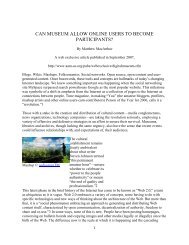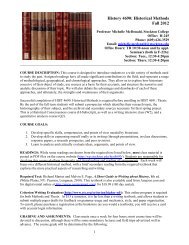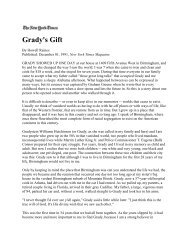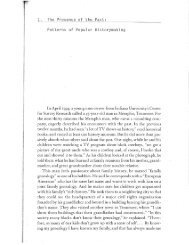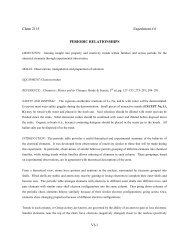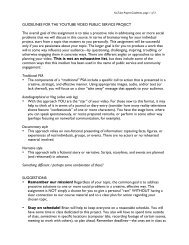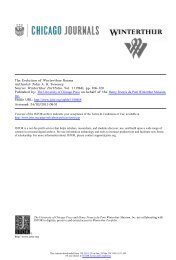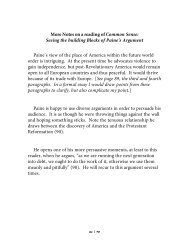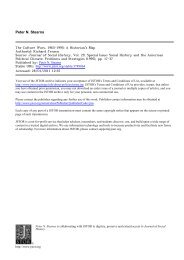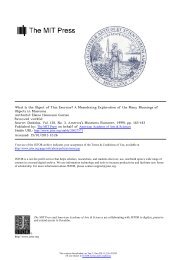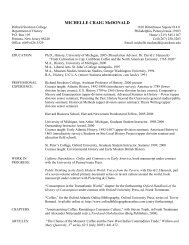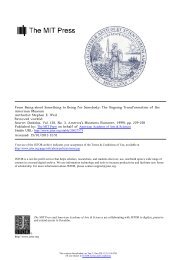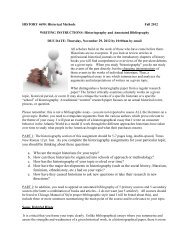Domesticating Barbie - Richard Stockton College Word Press ...
Domesticating Barbie - Richard Stockton College Word Press ...
Domesticating Barbie - Richard Stockton College Word Press ...
You also want an ePaper? Increase the reach of your titles
YUMPU automatically turns print PDFs into web optimized ePapers that Google loves.
252 Pearson and Mullins<br />
1997, p. 159). In 1984-1985 Mattel added a series of high-style dresses "From<br />
the Collection of Oscar de la Renta" designed by the fashion impresario (Sum<br />
mers, 1997, pp. 122-125). After 1989, a series of food manufacturers sealed<br />
agreements with Mattel to market <strong>Barbie</strong>s which would carry their company<br />
trademark on boxes, clothing, and accessories, including Ralston cereals (1989),<br />
Kraft (1992), and Kool-Aid (1992) (Augustyniak, 1995) (Fig. 11). Other uniquely<br />
dressed and branded barbies soon followed, including the 1989 "Pepsi Spirit<br />
<strong>Barbie</strong>;* F.A.O. Schwartz dolls (yearly since 1989), "U.N.I.C.E.F. <strong>Barbie</strong>" (1989),<br />
"Benetton <strong>Barbie</strong>" (1991), Wal-Mart (since 1987), J. C. Penney (since 1990),<br />
and "Bloomingdale's Donna Karan" (1994, 1996), among many others (Sum<br />
mers, 1997, p. 98; Westenhouser, 1994, pp. 146-147,166). "All American <strong>Barbie</strong>"<br />
(1990) came with a pair of Reebok athletic shoes (Summers, 1997, p. 13). Today<br />
the <strong>Barbie</strong> universe includes a vast range of endorsed commodity accessories as<br />
well, ranging from Mastercard to Crest (Fig. 12).<br />
<strong>Barbie</strong> has retained some nonconventional career options since the early<br />
1980s, but even they are somewhat domesticated. For instance, <strong>Barbie</strong> again took<br />
to space as an astronaut in 1985 (after NASA had finally included a female astro<br />
naut in 1983), but the 1985 <strong>Barbie</strong> astronaut was a fashion-conscious space traveler<br />
(Summers, 1997, p. 15). A line of "Astro Fashions" was marketed to clothe these<br />
chic astronauts, including outfits like "Dazzling Dancer" and "Galaxy A Go Go,"<br />
which suggested that astronaut <strong>Barbie</strong> was more invested in style than exploration<br />
and research (Summers, 1997, pp. 111-112). "Astro Fashions'" designer Carol<br />
Spencer enthused that "I thought <strong>Barbie</strong> would dress if she were on the moon"<br />
(Lord, 1994, p. 119) (Fig. 13). The 1993 "Police Officer <strong>Barbie</strong>" placed <strong>Barbie</strong> in<br />
a<br />
position of genuine authority, but the box displayed officer <strong>Barbie</strong> in a<br />
"glittering<br />
evening dress" which emphasized that <strong>Barbie</strong> never could be stripped of glamour<br />
(Rana, 1996, pp. 50-51).<br />
By 1983 the aerobics movement compelled Mattel to concede that many<br />
women of flesh engaged in more intensive exercise than their plastic archetype.<br />
In the 1970s <strong>Barbie</strong> engaged in various recreational leisures with modest physical<br />
exertion, primarily beach play and camping. An exception was the 1970-1971<br />
"Shape-Ups" set, a red leotard and tights outfit with hand weights,<br />
a twist exer<br />
ciser, and an exercise booklet written by the new<br />
realistically articulated "Living<br />
<strong>Barbie</strong>" doll (Eames, 1997, p. 112), but most <strong>Barbie</strong> exercise was quite restrained.<br />
Mattel transparently feigns ignorance of <strong>Barbie</strong>'s body, commonly explaining that<br />
<strong>Barbie</strong>'s prodigious breasts and tiny waist are functionally necessary to hold cloth<br />
ing on the doll or that she simply has nothing to do with sexuality. When Mattel<br />
apparently recognized the significance of the aerobics movement, <strong>Barbie</strong> was en<br />
listed, but her focus tended to be on workout style, not physical transformations<br />
or the workout process itself. The 1983 "Great Shape <strong>Barbie</strong>," for instance, came<br />
outfitted in snappy leotards and leg warmers and (in some packages) a Walkman<br />
personal stereo (Summers, 1997, pp. 36-37). The 1989 "<strong>Barbie</strong> and the All Stars"<br />
This content downloaded on Tue, 15 Jan 2013 10:45:42 AM<br />
All use subject to JSTOR Terms and Conditions



